In this blog we cover the boom of Rock and Disco in the 70’s & 80’s and how this represented a threat for Salsa music. We’ll also cover how Salsa evolved into a more “mainstream” version.
As I mentioned in my previous Part 2a blog, Salsa started its boom in the late 60’s and continued into the early 70’s and through the 80’s. During this time, Salsa was exploding with the strong sound of the many orchestra & singer combinations of the time. Fania was doing a super marking job. What would later be known as “Salsa Dura” (hard salsa) or “Salsa Clasica” (classic salsa) was in full swing.
Things started to change in the mid-70’s as a couple of significant events took place. Rock and the appearance of Disco began to experience a commercial boom. Luckily, Salsa was developing a more “mainstream” style that allowed it to ride the wave through the 80’s.
The Boom of Rock and Disco
In the mid-70’s, rock began a commercial boom, sparked by fusions with soul, R&B, and jazz. I’m not sure what exactly triggered the explosion of rock. It could have been the impact of the last albums of The Beatles, who broke up in the early 70’s and left a fascinating legacy as well as a huge void, which many bands jumped in to try to fill. Or it could have been the evolution of a variant of the genre.
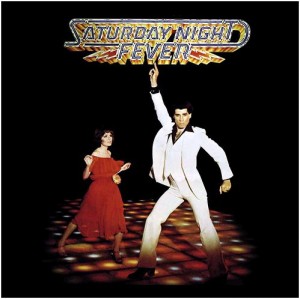
But whatever caused the boom, the result was a commercial success by artists like Chicago, Rod Stewart, Bee Gees, Elton John, Rolling Stones, etc. In the late 70’s, Disco was emerging and began invading the dance clubs.
The decade finished with a bang for Disco, with the mega-hit movie “Saturday Night Fever” starring John Travolta. The soundtrack of the movie, recorded mostly by the Bee Gees, with Gloria Gaynor adding a extra hit, became a huge commercial success. The “Travoltada”, like Ruben Blades would call it (or “Travolta-mania) was all over the dance clubs. Sales of white suits went to the roof.
The booming Disco and progressive Rock music were winning the hearts of young people all over the world, and Latinos were no exception. The younger generation flocked disco clubs, many now preferring these over the salsa salons.
MTV; adding salt to the wound
The boom of Rock and Disco got a second big infusion, when MTV (Music Television) was introduced by cable companies in 1981. Michael Jackson was one of the 1st artists to take full advantage of showcasing his music and dancing abilities to go with it, on the new cool TV channel.
First with “Off the Wall”, but later with his mega-hit “Thriller” in 1983, Michael Jackson dominated the music world, earning the nickname “King of Pop”. “Thriller” became the biggest selling album of all-time, a title it still holds. If Michael Jackson was the “King”, Madonna became the “Queen”.

Madonna used her good looks, sexy songs, and provocative outfits to practically take over MTV airwaves. Her albums “Madonna”, and specially “Like a Virgin” became huge successes, launching a very successful and lucrative career in the MTV era, for which Madonna was a perfect fit.
And from there it just kept “raining over wet” as we say in Puerto Rico. MTV showcased and magnified the commercial success of many artists throughout the 1980’s, among them Genesis & Phil Collins, The Police & Sting, Van Halen, Journey, Paul McCartney, John Lennon, Lionel Richie, Tina Turner, Billy Joel, Cyndi Lauper, Huey Lewis, and many others.
The music was very mainstream, and MTV was the perfect marketing tool for it. Salsa had its work cut out for it, if it wanted a piece of the public’s music money.
Salsa’s Timely Evolution to “Mainstream”
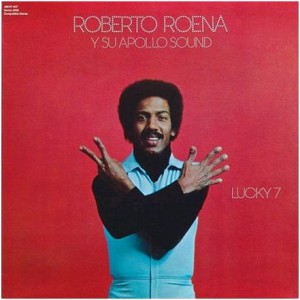
As Rock and Disco began their booming success in the mid-70s, Salsa was doing its own evolution. Salsa bands began to mature, and using the dynamic nature of the genre, artists began to experiment with ways to take Salsa to the next level. What most listeners found was a mellower, more calmed variant of the music.
This movement towards a “mellower” sound is best reflected in the Roberto Roena’s Apollo Sound super-hit “Mi Desengaño”, as part of his “Lucky 7” album (1976). Having a smooth arrangement, a very “jazzy” trumpet solo between the intro and the “soneos”, and a “bossa nova” mambo in the middle, “Mi Desengaño” became hugely popular not only with established “salseros”, but more importantly, with people that did not prefer Salsa up until that time.
The catchy and somewhat purposeful lyrics complemented the music, and because of it, Roena played in many more Senior Proms in 1976 and 1977, than he would normally have otherwise.
[Note: you can read more on the history of Roena and my favorite Apollo Sound songs in the blog series “The Legend of Roberto Roena”, HERE.]
Sonora Ponceña, Willie Colon & Ruben Blades Join “Mainstream”
That same year, La Sonora Ponceña had a similar experience with their hit album “Musical Conquest” (1976). Papo Lucca experimented a bit in this album, trying to improve on their previous release “Tiene Pimienta”, which was a great hit and their best selling album until then.
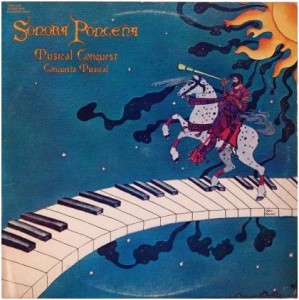
Lucca and La Ponceña stroke gold in “Musical Conquest” with the hits “La Clave” and “El Pio Pio”. Similar to Roena’s “Mi Desengaño”, these songs were mellower, and Papo Lucca introduced a flute to the typical “Sonora” trumpet-only wind section to smooth out the mambos.
The mambos had flares of bossa nova, and singer Luigi Texidor was at the peak of his game, making witty and funny “soneos” and comments throughout the songs, helping make this album a huge hit, and attracting a huge crowed of ‘non-salseros”.
These “non-salseros” where people that would listen to a little of everything (pop, balada, rock, disco, trova, etc.), but would not classify themselves as “salseros”, and probably never bought a Salsa album before. But with this new style of Salsa, they began acquiring their first Salsa records. La Sonora Ponceña had also moved mainstream.
Many other bands were going mainstream with their salsa. Willie Colón hooked up with a young Panamanian called Rubén Blades to revolutionize the genre beyond mainstream, but I’ll focus on them shortly.
…also El Gran Combo & Cheo Feliciano
El Gran Combo released several “mainstream” hits, starting with “Nido de Amor” in their album “Aqui No Se Sienta Nadie” (1979), and repeating the dose with “El Licor de tu Boquita” in their album “Unity” (1980). The same happened with “El Telefono” and “Goyito Sabater” in their mega-hit “Nuestro Aniversario” (1982). Cheo Feliciano released the albums
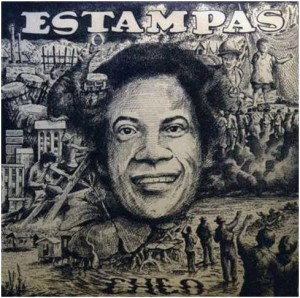
“Estampas” (1979) and “Sentimiento Tu” (1980), which were very “mainstream” with hits like “Los Entierros”, “Estampa Marina”, and “Juan Albañil” written by Tite Curet Alonso, and “Así Soy” and “Amada Mía”, the first compositions of José Nogueras for Cheo Feliciano. Both were great albums, with a good mix of rhythms, excellent lyrics, great arrangements by the maestros Luis Garcia and Papo Lucca, and impeccable execution by Cheo Feliciano and his star lineup of recording musicians.
These albums had great acceptance among the general public, providing Cheo Feliciano great commercial success. Ismael Miranda released “No Voy al Festival” (1977) and “Double Energía” (1980) with Willie Colón, which included the José Nogueras hit “No Me Digan que es Muy Tarde”. Many more artists followed the mainstream trend, helping Salsa stay commercially afloat in a tough time.
In this clip, Cheo talks about the evolution Salsa was having during these years. He also gets to sing the first part of “Los Entierros”.
During this period Salsa in general was looking for this more mainstream sound, although not everyone, went in this direction. Willie Rosario, who preferred the hard line style of Salsa, had a hit song “Busca El Ritmo” which calls for the public to take preference on their musical roots rather than on imported genres. At one point in the song, singer Tony Vega bursts out “Rockero, fuera, fuera, fuera” (Rocker, out, out, out).
Willie Rosario Brings “Afinque” Mainstream
Willie Rosario didn’t soften much his musical style, which already was heavily influenced by Latin Jazz. Rosario normally added a Latin Jazz cut or two to his recordings.
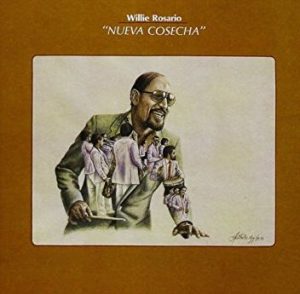
However, with the addition of singer Gilberto Santa Rosa to his lineup in 1984, Willie Rosario began to soften his arrangements, just a bit. Additionally, he also added more love-themed songs to his albums, for Tony and Gilberto to shine.
Santa Rosa was perfect for this, delivering these songs with grace, charisma, and ingenuity. This resulted in mega-hits for Willie Rosario, which included “Botaron La Pelota” and “Enamorado a lo Adivino” from the album “Afincando” (1985). He also had the hit “Me Tendran Que Aceptar” from the album “Nueva Cosecha” (1986).
Tony Vega was the other singer in Willie Rosario’s orchestra. Tony’s tone matched well with Gilbertito’s and also was a great “mainstream” Salsa singer. Both Tony Vega and Gilberto Santa Rosa proved they could sing these songs as well as anyone.
In “Lluvia”, released in the album “Nuevos Horizontes” (1984), they paired nicely to deliver another Willie Rosario mega-hit. “Lluvia” is a loved-themed song, with the Salsa Dura and “afinque” of Willie Rosario. Written by Cuban Adalberto Alvarez and arranged by Tito Puente alumni Jose Madera, “Lluvia” delivers on content and musicality. Additionally, notice how synchronized the orchestra is both in the front and in the back.
Salsa Evolution in Puerto Rico & New York
In Puerto Rico, there were a couple of other artist which is worth mentioning. Raphy Leavitt and his La Selecta orchestra always maintained a high standard of music. Part of his repertoire was kind of the softer mainstream trend. One of my very 1st favorite salsa tunes, was Raphy Leavitt’s “La Cuna Blanca”(1972).
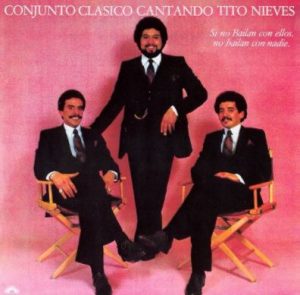
In the mid-70s, while the cross-over movement started to take place, Raphy Leavitt delivered the hits “El Buen Pastor” and “Te Arrepentiras” as part of the album “De Frente a la Vida” (1976), which had good acceptance by the new mainstream market which had just dicovered Roena, El Gran Combo, and La Sonora Ponceña.
In New York, Luis “Perico” Ortiz and Conjunto Clásico were bands that came out with new musical styles . Perico came out with a salsa orchestra with a heavy dose of Jazz elements in its arrangements. On the other hand, Clásico came out with a typical conjunto sound and songs which reflected mostly small town living in rural Puerto Rico. These songs were all written by Clásico co-founder and composer extraordinaire Ramón Rodriguez.
However, although both of these bands had great commercial success, it was mainly due to hard-core “salseros”, not by appealing to mainstream listeners. Luis “Perico” Ortiz did record some hits that cross to the mainstream audience, like “Alabao” and “De Patitas”. The mainstream public enjoyed the basic rhythms within Salsa, but preferred something softer than “descargas” and heavy solos. Songs like Tito Puente’s “Para los Rumberos” wasn’t made for them.
Rubén Blades Brings Social Stories & Messages
A big boom to the mainstream tendency was provided by the guy Willie Colon brought to replace Hector Lavoe. Rubén Blades, who had recorded in New York previously with Pete Rodriguez’s Orchestra (“From Panama to New York” – 1970) and with Ray Barretto (“Barretto” – 1975), joined Willie Colón to record a different kind of salsa. Blades was able to do with Colón what he couldn’t do with Barretto. Ray Barretto liked the traditional Afro-Cuban sound and jazzy style, and was not eager to experiment with socially-charged themes in songs.
Willie Colón welcomed the experiment, and they ran their 1st experiment by recording the song “El Cazanguero” in the album “The Good, The Bad, and The Ugly” (1976). The song was about the loneliness prisoners feel by losing their liberty. Ruben had visited a jail in Panama as part of his Law School work, and it inspired the song.
But their big coming-out together came with “Metiendo Mano” (1977) when Willie Colón officially introduced Rubén Blades. Songs like “Pablo Pueblo”, “Pueblo”, and Tite Curet Alonso’s “Plantación Adentro”, which told social stories or messages, were well received by the general public. But it was their next album which would make history.
The Amazing “Siembra”

“Siembra” (1978) became the best selling salsa album of all times. With hits like “Plastico”,“Pedro Navaja”, and the title song “Siembra”, Rubén Blades established himself as a different kind of “salsero”. Ruben was an intelligent and educated “salsero” with a different message.
The fact that he had a law degree from the University of Panama gave him more credibility. It also helped that the only hits the famous Fania All Stars had thereafter, “Juan Pachanga” (1977) and “Sin Tu Carino” (1978) would be Rubén Blades hits.
The song “Plastico” was a direct attack at the boom of Rock and Disco. The funky intro, and the plea to forget the “Travoltada” aimed at this. With Ruben, Willie Colon wanted to re-establish Salsa among Latinos.
Rubén Blades used our rich rhythm of Salsa as a means to carry a more meaningful message than what it had been conveying before. He wanted to raise the awareness of people to the situations surrounding us. Once we become aware and face the situations which affect us, instead of trying to escape from them with funny but meaningless lyrics, then we can start to move towards a way to solve problems or improve those situations.
The Funny and Romantic side of Ruben Blades
But Rubén Blades has a funny side too. He started the whole string of the “telefonito” (phone) songs. Ruben also added a few funny songs to the album “Canciones del Solar de los Aburridos” (1981).
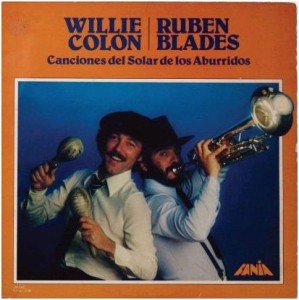
Besides the story of the guy avoiding the call from the girl (“El Telefonito”), he also wrote a funny tune called “Madam Kalalú”. This song is about a fortune teller which wants to take all of Willie’s money. Here, Blades begins to unveil the problems some musicians were having with Fania Records. Towards the end of the song Madam Kalalú finally reveals to Colón and Blades…”yo veo un barco que se esta hundiendo; y el capitán es el flaco mulato ese, que no sabe nadarrr…Todo el mundo en ese barco esta corriendo pa’ to’s la’os…” (I see a sinking ship, and the captain is that skinny ‘mulato’ who doesn’t know how to swim….everyone in that boat is running away…), in obvious reference to what was happening in Fania Records (the boat).
The album also had a more serious song “Tiburón” (Shark) which alluded to the intervention of the United States in Latin America. Its lyrics called to keep him away. The song was seen as “leftist’ by the Miami Cuban community.
With his way to raise awareness to a social situation (“Siembra”), or to tell the story we see in our neighborhoods (“Ligia Elena”), or to tell a love story (“Sin Tu Cariño”), Rubén Blades changed the way Salsa had been used until then. He made it a vehicle to transmit any message we want to transmit. Rubén Blades chose a meaningful message most of the time.
The Decline of the Fania Empire
As Rubén Blades was predicting (through Madam Kalalú), Fania was in the decline. I have never read or heard a full story of what caused the Fania decline. However, from what I’ve read and heard, it seems that greed had a lot to do with it.
Seems that Fania owners were making all the money and artists were left with the small end of the stick. There were endless unpaid royalties, and Rubén Blades was one of the first to stand up to this head on. He wanted for musicians, composers, arrangers, etc., to get their due part of the share. Fania was not sensible to this request, and many artists feared angering Masucci and the Fania management by speaking up. Not Blades.
However, artists began “jumping ship”. Bobby Valentín was one of the first to leave Fania Records. He must have left in good terms, as he remained as part of the Fania All Stars. Bobby left to start his own Bronco Records. Soon, many other artist followed suit, going to Sony Music, or other recording labels.
The exodus of artists, and the failed attempts to crossover the Fania All Stars, trying to ride the booming success of Rock & Disco, resulted in a series of commercial flops. As previously described, the public taste was now shifting to the booming rock and disco. Later in the 1990’s it would be “merengue” that would compete with Salsa for the public’s preference.
Conclusion
Fania didn’t have new incoming artist to influx new blood and energy to record sales. Aging fans were now raising kids and no longer going to clubs. The old salsa stars were leaving the label or retiring. Salsa was in bad shape, but it would survive, thanks to the mainstream salsa. This softer more orchestrated Salsa would maintain the groups working and selling records. Meanwhile, Fania had lost everything that made the label great in the 70s.
Fania faced competition from other big labels offering Fania angry stars better contract terms. The Fania All Stars were flopping. Fania was seriously ill by the end of the 80’s, and would not survive the “merengue” boom of the 90’s.
Veteran producer Ralph Mercado founded RMM Records in 1987. He aimed to fill the gap that Fania Records was leaving. He singed many of the Salsa stars of the golden years, and provided the public the music they wanted.
The roots of Salsa were deep, and survived the 80s with its mainstream style of Salsa. Rubén Blades brought a new message to the genre. However, another force was emerging during the mid-80’s which would also help Salsa survive the 80’s into the 90’s. The mid-80s saw the beginning of the “Salsa Romántica” movement, which gave Salsa an extra lift.
Next in the Salsa Music History Series
Salsa Ups and Downs: the threat of “Merengue” and the role of “Salsa Romántica”.

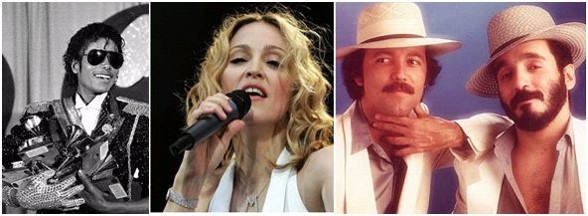
[…] Note: you can read more about the Salsa mainstream fad in the History of Salsa blog series HERE. […]